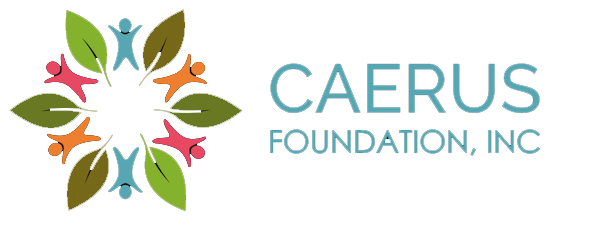Discussion Guide
The Film

Gilberto Sandoval, Pilsen Resident
This engaging, new, one-hour documentary is an intimate, street-level look at what community engagement and activism have done for a particular Chicago neighborhood: Pilsen. The residents of this predominantly Mexican-American working-class community have spent decades organizing around pressing societal issues ranging from housing and health care to education and citizenship. Much like a street mural come to life, the cumulative power of those decades of work is explored through the experience of six Pilsen residents. Viewers are drawn into the reality of life for a college student, a health care worker, two community activists, a café owner, and a retired steel worker – as well as for their colleagues, friends, and family members – as they face immediate challenges to family security, immigration rights, gentrification, the 2016 election, and unexpected death.
Told entirely through the voices of the featured Pilsen residents, speaking in both English and Spanish, My Neighborhood: Pilsen provides an inspiring example of what people working together can do to solve problems and transform homes, businesses, and community centers into better places to live, learn, work, and play.
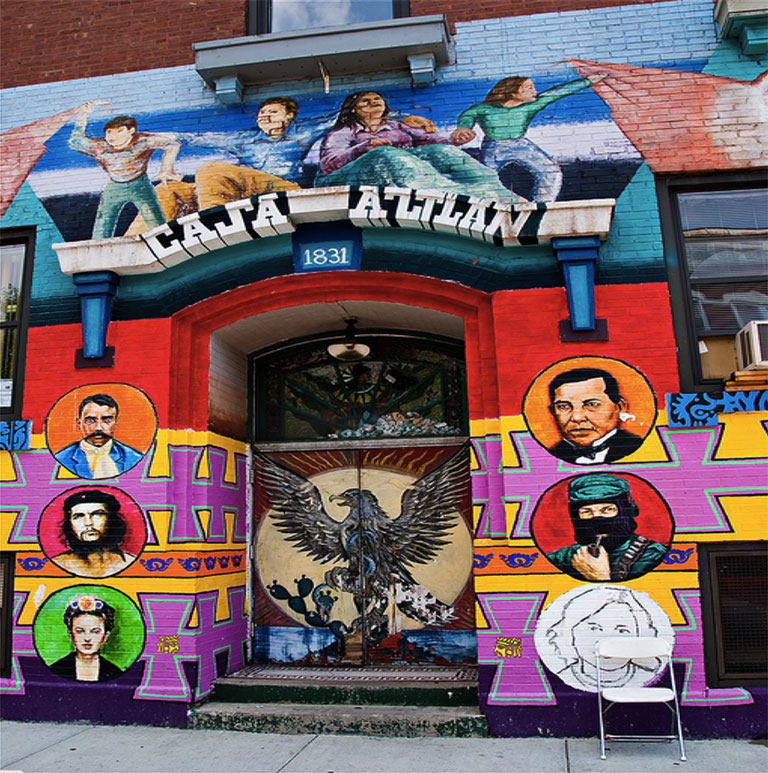
Casa Aztlan Mural in Chicago's Pilsen Neighborhood
From the Filmmaker
The late Chicago Sun-Times movie critic Roger Ebert wrote, “The movies are the most powerful empathy machine in all the arts.” He went on to write that movies allow us to spend time in someone else’s experience, even if, especially if, they are very much unlike us. In the process, our world, and our consciousness, expands.
If you’ll allow us the luxury of calling our TV documentary a movie, we set out to use this great machine of empathy to tell the story of the people of Pilsen whose lives are so powerfully devoted to improving the quality of life in their community. It was our (meaning the entire production team, including the cameraman, the editor, and the composer) belief that when viewers see and hear the details of these people’s lives, they will be drawn in and become participants—active, engaged participants rather than solely viewers – in the hopes, dreams, and concerns of the people of Pilsen.
We wanted the viewer to be with Raúl Hernández when he sat at his kitchen table, raised his fist in joy, and said, “We can do it!” We wanted the viewer to be astonished and moved to a new perspective after hearing Carmen Velásquez, founder of Alivio Medical Center, say that she wasn’t a doctor or a nurse or a person educated in medicine. And we hoped that watching Alma Silva’s family work through the fear that two daughters might be deported would personalize an attention-grabbing headline and bring it to life for the audience.
Why get drawn in? Our hope is that once an audience is engaged, they will realize the people on screen are not that different from them, and the important work they have achieved in their neighborhood is something any one of us could do ourselves if we just began.
We believe this guide is an amazing tool that will expand on our intentions through a program for active engagement with those moments of empathy, those moments of expansion when you, the viewer, were drawn in and for a moment found yourself empathically considering your part in this story, your own participation in the work of making a difference, of changing your home, your block, your community, your world. It is a power we truly believe lies within each one of us.
— Daniel Andries, Producer and Co-Writer
My Neighborhood: Pilsen
Using This Guide

Maria Pesqueira, Mujeres Latinas en Accion
This discussion guide will help support educators, students, and organizations who view My Neighborhood: Pilsen and wish to use the film to initiate discussion and engagement with audiences of all sizes, ages, and backgrounds about the themes and content of the film.
This guide can be used as a tool to broaden the scope of post-screening discussions and encourage viewers to be inspired and motivated by the subjects of My Neighborhood: Pilsen. From deeply rooted community organizers such as Raúl Hernández of The Resurrection Project who have transformed their community through development and progress to younger activists such as Lauren Ángeles of the Alivio Medical Center who are learning the power of their voice and actions, the film demonstrates that it is the residents of a neighborhood that shape and improve their community.
“A community that is well organized can do crazy, amazing things.”
— Lauren Ángeles, Regional Project Manager, Alivio Medical Center
Through the guide, audiences are encouraged to look at their own neighborhoods, to examine their understanding of “community,” and to problem solve alongside other neighborhood activists. Viewers are invited to work together to examine challenges familiar to their experiences and spark conversations that can lead to solutions and action within their own communities.
Resources related to the film and its subjects are provided, connecting audiences to organizations across Chicago working to make the city stronger as a whole.
Audience and Screening Suggestions
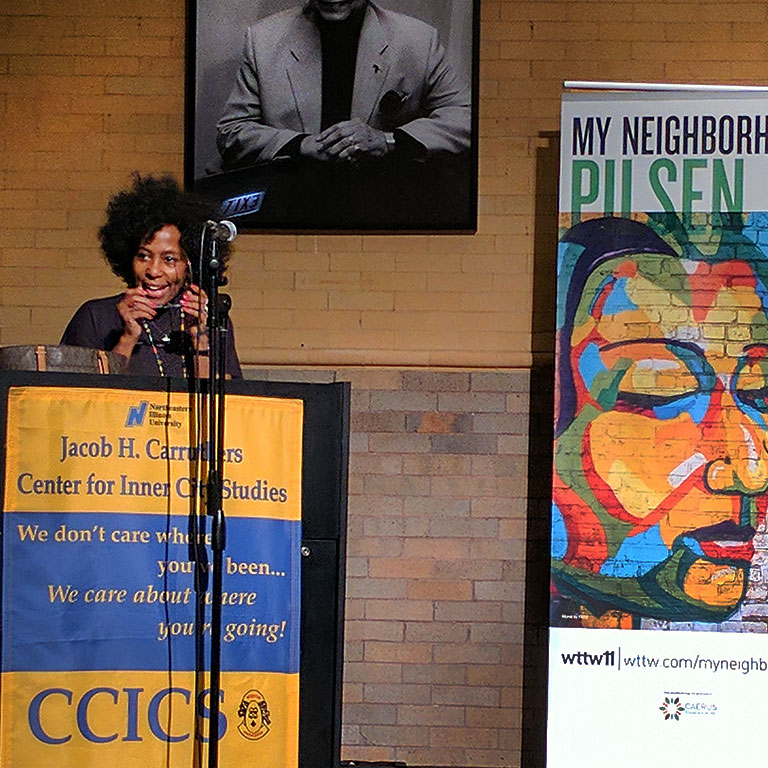
Immigration Meeting in Pilsen Neighborhood
My Neighborhood: Pilsen acts as a springboard for conversations about activism and community engagement. When thinking of a potential audience, consider the conversation opportunities. Can someone involved in the film speak with your audience? Can you provide additional resources or partner with an organization to make the discussion richer? Consider welcoming a community organizer or neighborhood activist to the screening to share with the audience about their experience of implementing change.
Appropriate discussion settings include but are not limited to:
- Classrooms
- Community centers
- Social justice centers
- Art centers
- Faith-based organizations
Vocabulary
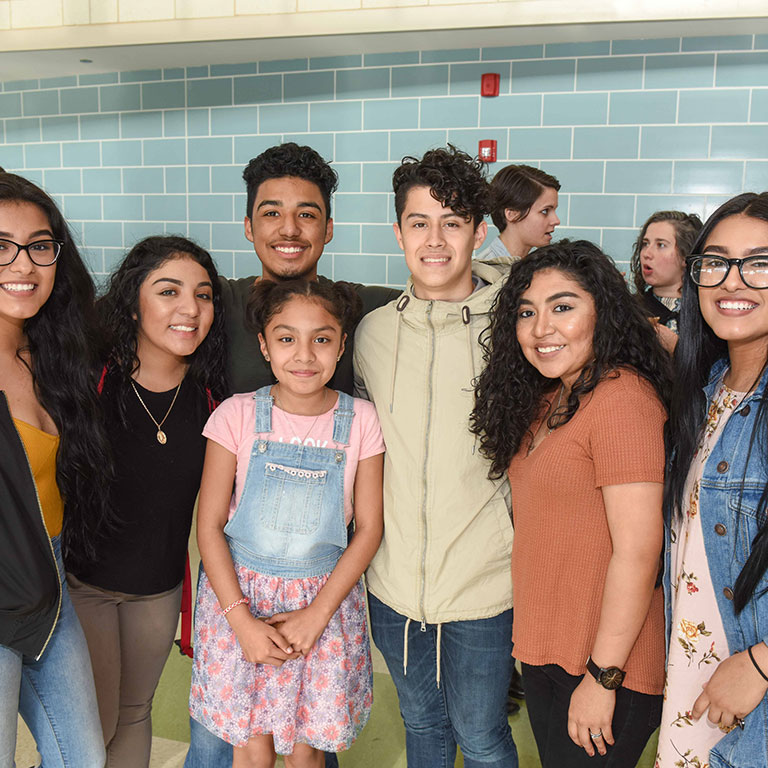
Youth from Pilsen Neighborhood
The following vocabulary can provide context for screenings and discussions of the film.
-
Gentrification
The process of renewal and rebuilding accompanying the influx of middle-class or affluent people into deteriorating areas that often displaces poorer residents. -
Social Justice
Justice in terms of the distribution of wealth, opportunities, and privileges within a society. -
Civic Participation
Individual and collective actions designed to identify and address issues of public concern. Civic participation can be defined as citizens working together to make a change or a difference in the community. -
Community
A group of people living in the same place or having a particular characteristic in common; a feeling of fellowship with others as a result of sharing common attitudes, interests, and goals.
Sources:
Merriam-Webster dictionary, American Psychological Association
Chicago – A City of Neighborhoods
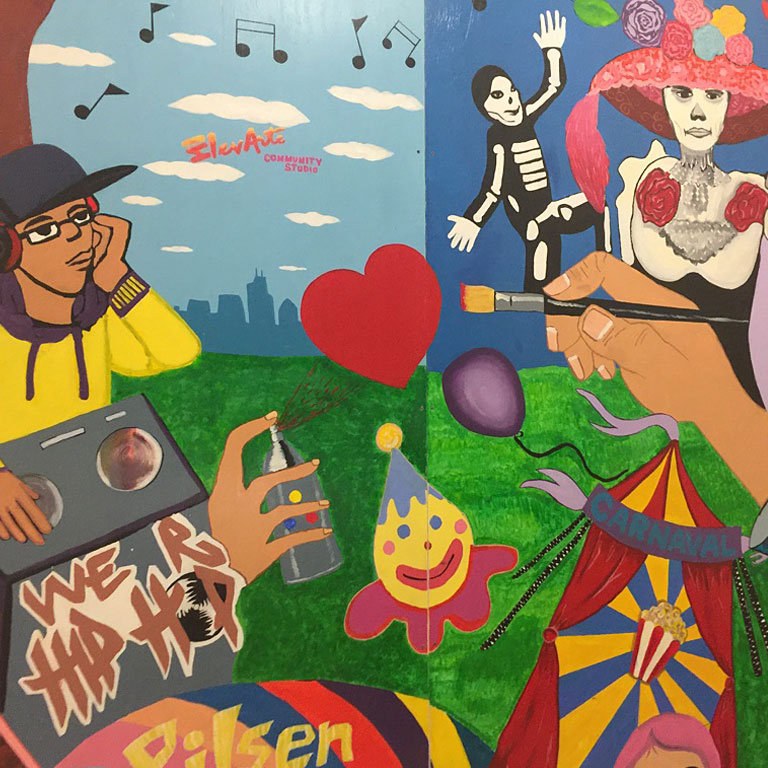
Mural at ElevArte
Visit any tourist shop along Michigan Avenue and you’ll find posters of a map of Chicago broken into the more than 200 neighborhoods that make up the Windy City. Chicagoans – natives or transplants – know that the question “Where do you live?” doesn’t mean “What street do you live on?” It means “What neighborhood do you live in?” The neighborhoods of Chicago present more than 400 neighborhood festivals each year: Do Division Street Fest, Andersonville Midsommarfest, and Chinatown Summer Fair, to name just a few. Be careful not to disparage a Chicago neighborhood–its residents tend to be fiercely loyal, die-hard fans of their own backyards.
“The people make this neighborhood, just like the people make our city. Our city doesn’t make us.”
— Maritza Rocha, Director of Youth Services, Mujeres Latinas en Acción
Chicago's neighborhoods stretch from as far north as East Rogers Park to as far south as West Pullman. As the city has evolved, so have its neighborhoods. Each is unique in its origin, history, triumphs, and challenges. Looking at neighborhoods from the outside, historians and city planners can see the movements of growth: streets extend, buildings are erected, and populations ebb and flow. But it is from within these neighborhoods and through its residents that the real experience and identity is understood. Pilsen, for example, was “founded” in the 1870s when its majority Czech residents called the area “Plzeň” after West Bohemia. The name morphed into “Pilsen,” though as film subject Gilberto Sandoval says as he walks the neighborhood streets, “I never knew that this place was called Pilsen. My whole life it was called ‘Le Dieciocho,’ which means ‘Eighteenth Street.’”
Sources:
City of Chicago, 2017
Encyclopedia of Chicago, 2005
Assessment: My Neighborhood
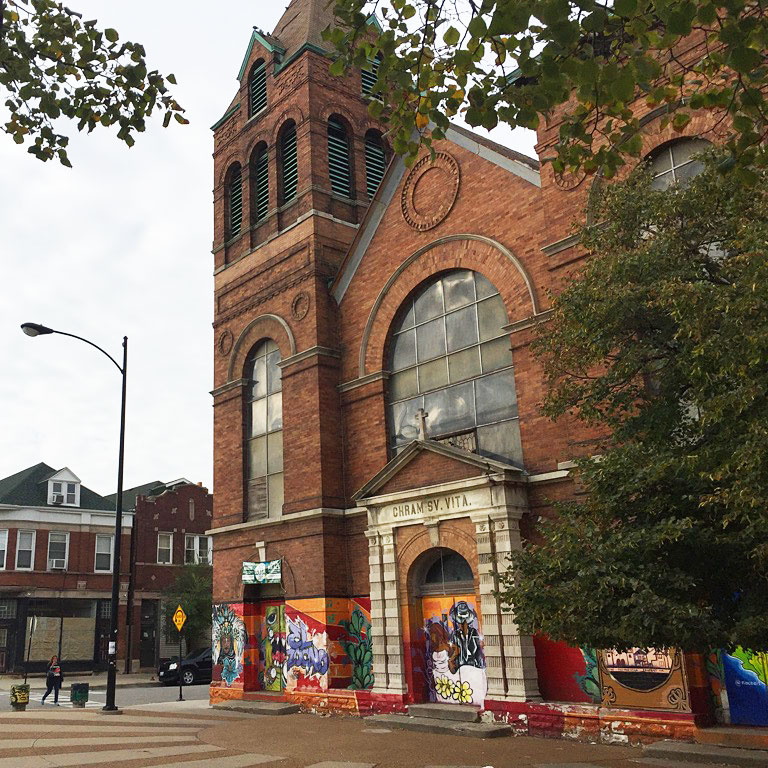
St. Vitus Catholic Church in Pilsen Neighborhood
My Neighborhood: Pilsen introduces audiences to the leaders and residents of Pilsen, familiarizing viewers with the streets and stories of the city blocks that make up the community. While the film focuses on Pilsen, the goals and ambitions of its subjects are universal: safe housing, good education, strong and healthy families, and happy lives. Consider your neighborhood and answer the questions below.
- If I could do one thing to improve my neighborhood, I would:
- The most important aspect of my neighborhood is:
- When people think of my neighborhood, I want them to think:
- It’s the weekend—what are you doing in your neighborhood?
- You receive a large donation to spend in your community. What’s the first thing you do with the money?
If you answered mostly A:
You prioritize the commerce of your community: the more successful the small businesses in your neighborhood, the better quality of life for the residents and interest in your neighborhood as a tourist destination. In My Neighborhood: Pilsen, Diana Galicia’s La Catrina Café is profiled as a space where members of the community can enjoy delicious coffee drinks and hang out. List your favorite neighborhood businesses and why you love them.
If you answered mostly B:
You care most about the culture and history of your community: by embracing the past, artists and leaders can show the next generation through art what defines your neighborhood. My Neighborhood: Pilsen highlights organizations such as Yollocalli Arts Reach and the National Museum of Mexican Art as places that encourage young artists to weave their cultural experience into their artistic expression and understanding. List five places in your community that exhibit or highlight local artists and culture.
If you answered mostly C:
The health and wellness of community members are most important to you: by providing reliable health care, housing, and resources for residents, neighborhoods can thrive. In My Neighborhood: Pilsen, the Alivio Medical Center has become a trusted center for all of Pilsen, from seniors to young families. Identify a facility in your neighborhood that offers services for health or housing for low-income residents. If you can’t name one, research your neighborhood to see if one exists. If one does not exist, explain why you think it does not.
Neighborhood Profiles
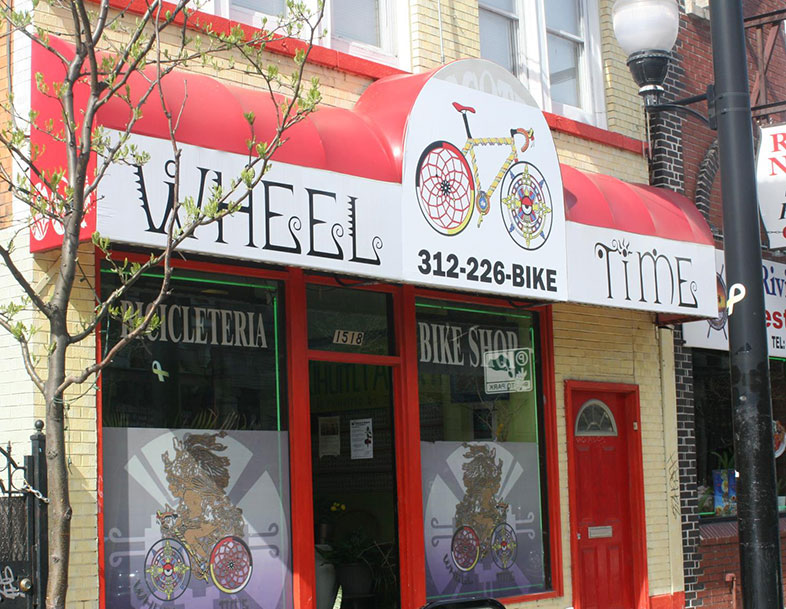
Wheel Time Bike Shop in Pilsen Neighborhood
With so many neighborhoods in Chicago, there are also organizations that are unique to the challenges within those neighborhoods. Below are profiles of two Chicago organizations that have tackled challenges and worked to find solutions to make their communities better.
Neighborhood: Uptown
Organization: Inspiration Corporation
Interview with Evan Cauble-Johnson, Chief Development Officer
Q: What is the mission of Inspiration Corporation?
A: In an atmosphere of dignity and respect, Inspiration Corporation helps people who are affected by homelessness and poverty to improve their lives and increase self-sufficiency through the provision of social services, employment training and placement, and housing.
Q: What was the challenge that Inspiration Corporation identified and aimed to solve?
A: Inspiration Corporation was founded in 1989 by Lisa Nigro, a police officer who was searching for a personal response to the people she encountered on her beat. Lisa was working on Chicago’s West Side in the Garfield Park neighborhood, and she regularly interacted with individuals struggling with homelessness, deep poverty, substance use, mental health issues, criminal records, and mental and physical disabilities. Lisa wanted to find a way to help them restore some dignity to and make positive changes in their lives.
All participants share a determination to improve their situation through their resiliency, resourcefulness, and depth of life experience. Inspiration Corporation’s client-centered service provision model provides flexibility to address the complex challenges and supports the unique strengths of each participant.
Q: How does the organization work to address the challenge?
A: When Lisa Nigro founded Inspiration Corporation, she borrowed her nephew’s red wagon, filled it with coffee and sandwiches, and pulled it around the Uptown neighborhood of Chicago, treating the people she encountered with dignity and respect. Lisa chose Uptown because of the high concentration of individuals experiencing homelessness or spending the majority of their time on the streets.
Over time, the wagon grew into a van, a bus, and eventually the full-service Inspiration Cafe, where men and women experiencing homelessness could sit down, order from a menu, and be served. The Inspiration Cafe creates a unique, supportive community to serve participants high-quality, healthy, nutritious meals in a dignified, respectful atmosphere. The agency serves nearly 20,000 meals annually to improve participants’ health and wellness, prepared and served by volunteers five mornings and four nights each week. The menu varies each day, accommodating individual dietary restrictions and preferences. In the years that followed the founding of Inspiration Cafe, Inspiration Corporation expanded its services beyond simply meals to include case management, supportive services, housing, and employment training.
Q:Why is Inspiration Corporation as important and relevant today as it was when it was founded?
A: The population Inspiration Corporation serves resides primarily in areas that have been experiencing chronic poverty and unemployment for decades, including Uptown, a now-gentrifying neighborhood where 10 percent of the population live in extreme poverty, and 24 percent live below the federal poverty line. Inspiration Corporation’s programs provide these individuals with a refuge from life on the streets and a pathway out of poverty.
Neighborhood: Little Village
Organization: Beyond the Ball
Interview with Jackie Covarrubias, Managing Director
Q: What is the mission of Beyond the Ball?
A: In 1998, Rob and Amy Castañeda moved into the Little Village neighborhood of Chicago, a primarily Mexican community on the west side of Chicago. Shortly thereafter, a local gang threatened their lives. Twice the gang attempted to burn down the Castañeda’s home, shattering their front window with bottles, after learning that Rob had talked to the police when he witnessed a crime by its members. Instead of leaving the neighborhood, the Castañedas responded by getting more involved in the community.
Amy, who had been teaching at a local elementary school, transferred to another school closer to their home, and Rob started coaching the school’s basketball team. In order to compete, the basketball players needed extra practice, so Rob opened the school gym on Saturdays. Access to basketball courts in the neighborhood was restricted due to gang boundary lines, so word of a safe place to play spread quickly. The kids on the team asked if they could bring relatives, then friends. Soon many other kids from even outside Little Village wanted to join. It wasn’t long before 70 youth were regularly coming for open gyms. One suggested that Rob start hosting tournaments, and the gym was filled with neighborhood kids most evenings and weekends, even through the summer months.
The mission of Beyond the Ball is to harness the power of sport and play to reclaim space, unite the community, and create a culture of opportunities through which we cultivate hope and change lives.
Q: What was the challenge that Beyond the Ball identified and aimed to solve?
A: The “problem” that Beyond the Ball identified and aimed to solve was the lack of and need for safe, accessible play spaces in the community.
Q: How does the organization to work to address the challenge?
A: We address the challenge by utilizing existing green space for positive use. We activate community residents and develop a sense of ownership by offering free programming in public spaces.
Q: Why is Beyond the Ball as important and relevant today as it was when it was founded?
A: In order to impact and improve the culture of our community, we must engage and activate various generations of residents. As new generations emerge, we must instill in them the values that will create personally and socially responsible community stakeholders.
Activities For Post-Screening Discussions
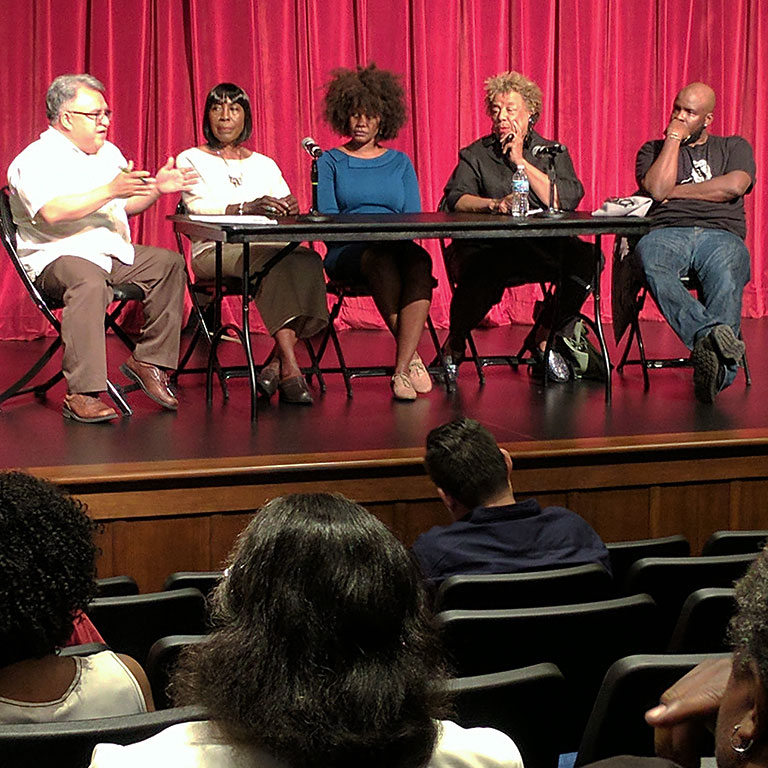
South Side Neighborhood Panel Discussion
The following activities can be implemented in both smaller, more intimate settings and in larger discussions.
Small groups of 5-10 / 20 minutes
- Participants spend five minutes individually thinking of no fewer than five words that mean “neighborhood” to them.
- After forming groups, participants spend five minutes sharing their words with one another.
- Each group works together for approximately ten minutes to use these words and phrases to craft a one- or two-sentence definition of the word.
- Each group presents their personal definition to the larger group.
Small groups of 3-4 / 20 minutes
- Within groups, participants study the two neighborhood organization profiles highlighted above. These neighborhoods were presented with a challenge which was addressed through community organizing and activism.
- Groups choose one organization and imagine they hadn’t been successful with their solution.
- Groups work together to find an alternate solution. Questions to answer: Why will your solution succeed? What resources will you need to make it successful? Who will need to be involved to keep it going? How might it fail?
- Each group presents their suggestion to the larger group.
Individual exercise / 10 minutes
- On their own, participants think of the neighborhood in which they reside and identify a single “problem” in the neighborhood. Trash pickup? A lack of afterschool programming for students? An abandoned building?
- Brainstorm five solutions. Is there a current neighborhood group that could take on the challenge? Is there an individual who might solve it? Does a new task force or group of people need to lead the charge?
- Ask individuals to present their ideas to the larger group.
Individual exercise / 5 minutes
- On their own, participants make a list of ten things they love about the neighborhood they live in.
Voices – My Neighborhood: Pilsen
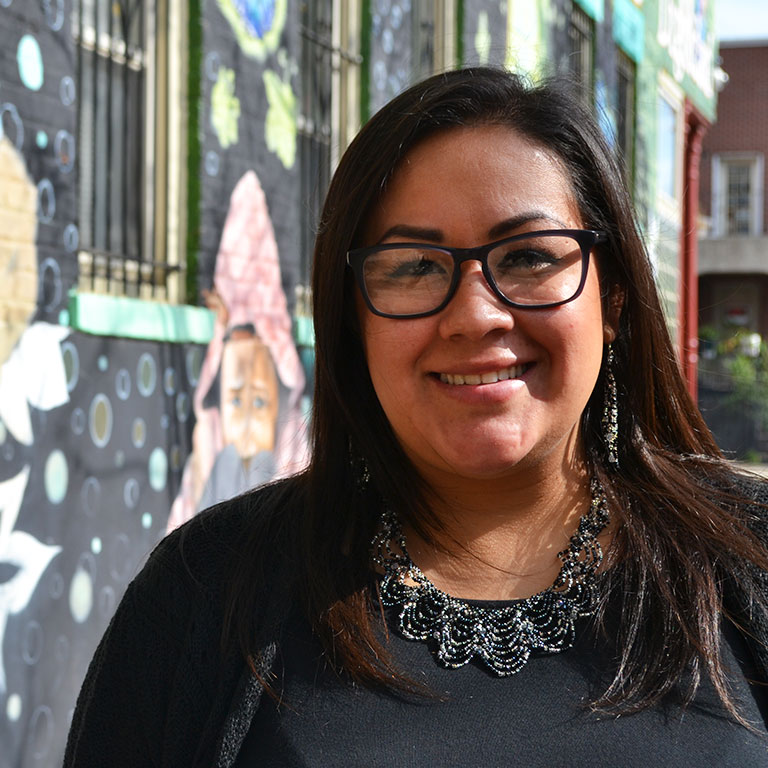
Anel Sancen, Pilsen Community Activist
The following quotations from the film can be used to generate dialogue or discussion.
Consider printing the quotations, projecting them on-screen, or posting them around the room in which the discussion is taking place. In small groups, participants can discuss an assigned quotation and discuss why the quotation, though unique to My Neighborhood: Pilsen, is applicable to any neighborhood or community.
“We see a need and then, right away, we do it ourselves.”
— Lauren Ángeles, Regional Project Manager, Alivio Medical Center
“What we have, nobody can take: family, values, language, history, culture, work ethic.”
— Carmen Velásquez, Co-Founder, Alivio Medical Center
“To me, the word leadership means power and guidance.”
— Alma Silva, Community Organizer, St. Pius V Parish
“When you talk about leadership, you are talking about commitment, you are talking about responsibility, you are talking about going further, you are talking about going to the root of the problem.”
— Alma Silva, Community Organizer, St. Pius V Parish
“If you want changes, we gotta make it ourselves”
— Raúl Hernández, Co-Founder, The Resurrection Project
“You know there are different types of leaders. There are self-proclaimed leaders, there are leaders who are elected, but I think the real leaders, with a capital ‘L,’ are the residents. People who step up, who want to address issues on their block, in their community. They don’t just talk about it, they take action.”
— Raul Raymundo, CEO, The Resurrection Project
Voices – My Neighborhood
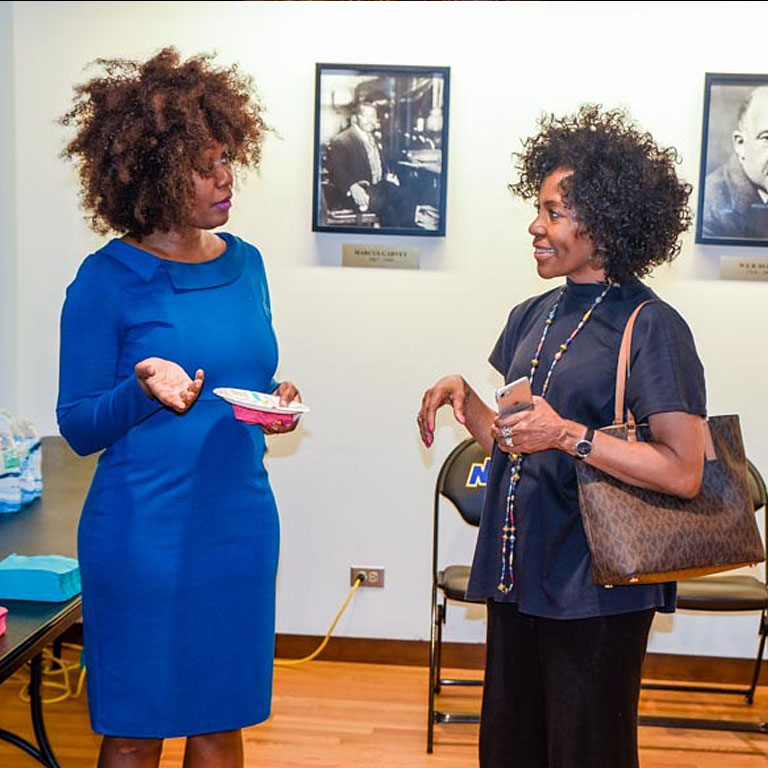
South Side Screening Hosted by Global Girls Inc.
Gather quotations outside of the discussion from residents about their own neighborhood and/or gather quotations from each other about their thoughts on leadership, civic engagement, and neighborhood growth.
It Takes a Village – Collaboration in “West Park”
For this exercise, read the following description of the hypothetical Chicago neighborhood of West Park and five community organizations within it. Then examine the three challenges facing the area and choose two organizations that can collaborate to solve each issue.
The neighborhood of West Park was historically an industrial area that has recently seen an influx of families after two high schools were built nearby. The community is diverse in age and background, though the area has a high population of older residents. The average income is considered lower middle class.
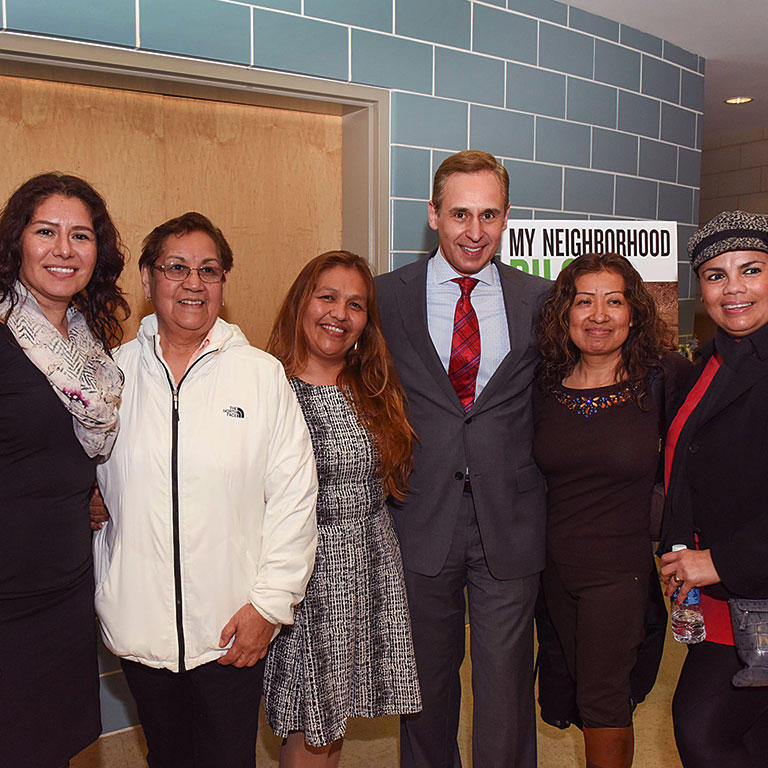
Community Meeting in Pilsen Neighborhood
Organization: West Park Art Space
Run by artists, West Park Art Space offers studio space for free during the weekdays and hosts small art shows every other Friday of the month.
Organization: Student to Student
Student to Student is a tutoring organization that connects 6-12 grade students with current college students for low-cost tutoring across all subjects.
Organization: Easy Bake
Easy Bake is a successful, family-run bakery that supplies numerous Chicago neighborhoods with muffins, cakes, cookies, and pies. All baking is done in an industrial kitchen without a storefront.
Organization: Second Act
This organization provides free transportation to seniors in the area. Users simply call the Second Act dispatch at least 24 hours in advance to arrange for a ride.
Organization: West Park Women’s Group
The WPWG’s mission is to push forward residential development in West Park, specifically affordable housing and housing that includes green space.
-
Challenge 1: Graffiti is on the rise. In the past few months, a number of buildings have been tagged, and a few high school students have been identified as some of the taggers. When caught painting the side of an apartment building, one of the students said, “Where else am I supposed to draw?”
Choose two organizations above to collaborate on a way to encourage these students. What resources can they combine to turn the graffiti into something more positive? -
Challenge 2: A residential building for seniors recently invited volunteers to come spend time with the residents who don’t get many visitors. Unfortunately, only one volunteer showed up.
Choose two organizations from above to collaborate on embracing the neighborhood’s senior citizens. Which organizations have the resources to provide companionship to the seniors and how? -
Challenge 3: The local coffee shop is struggling. The owner has great coffee but doesn’t have the overhead to provide anything but beverages, and the space has little ambiance with bare walls. Its best feature is the back courtyard.
Choose two organizations that might collaborate to help this struggling coffee shop. How can they raise money for the shop and/or make it a “cooler” place for people to spend their time?

